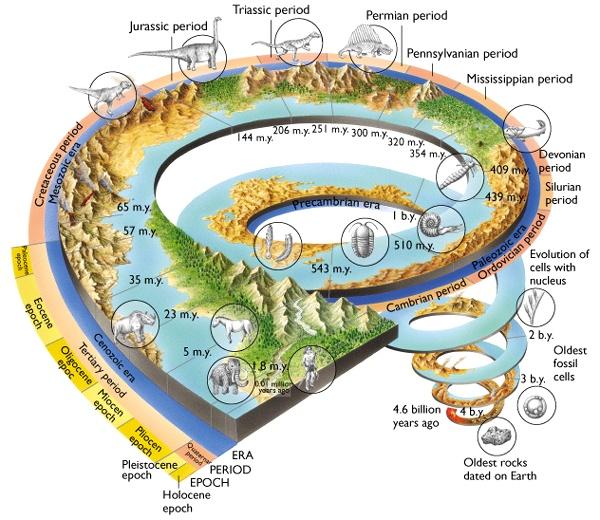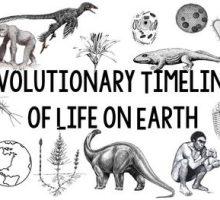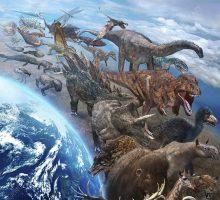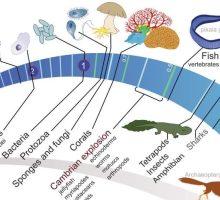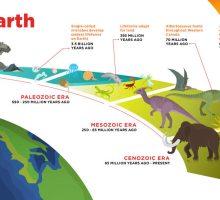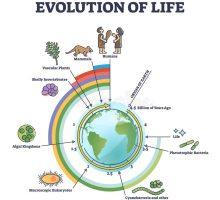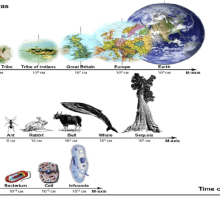- The origins of life on Earth: exploring the first living organisms
- The Cambrian explosion: a burst of evolutionary innovation
- Darwin’s theory of evolution: how it revolutionized our understanding of life
- Mass extinctions: the impact of cataclysmic events on evolution
- The rise of mammals: how they outcompeted other vertebrates
- Evolutionary adaptations: how organisms adapt to changing environments
- Human evolution: tracing our evolutionary lineage from primates to Homo sapiens
- The evolution of plants: from algae to flowering plants
- Evolutionary convergence: how different organisms can evolve similar traits
- The future of evolution: predicting the trajectory of life on Earth
- Conclusion
The origins of life on Earth: exploring the first living organisms
The origins of life on Earth have been the subject of scientific investigation and debate for centuries. Researchers have long sought to uncover the first living organisms and understand how they came to exist. Today, through a combination of cutting-edge technologies and careful analysis of geological records, we are beginning to uncover the mysteries of the earliest life on Earth.
At the heart of this quest is the question of how life began. One theory proposes that it arose from a primordial soup of organic molecules, while another suggests that it arrived on Earth via meteorites or comets. Recent research has shown that both of these possibilities are plausible, and that the first living organisms may have emerged from a combination of factors.
The earliest life on Earth was likely simple and single-celled, but it still represented a major breakthrough in the history of our planet. These organisms were capable of metabolizing nutrients and replicating themselves, paving the way for the emergence of more complex life forms over time.
One of the key challenges in studying the origins of life is that the earliest organisms have long since disappeared, leaving only traces of their existence in the fossil record. Nevertheless, researchers have been able to piece together a picture of what these organisms might have looked like based on their chemical composition and the conditions of the early Earth.
Despite the many unknowns, the study of the origins of life on Earth continues to captivate and inspire researchers around the world. By gaining a better understanding of how life emerged from non-life, we can gain new insights into the fundamental processes that underpin the natural world and our place within it.
The Cambrian Explosion: An Incredible Burst of Evolutionary Innovation
The Cambrian explosion is widely regarded as one of the most significant events in the history of life on Earth. This period, which took place approximately 541 million years ago, marked the emergence of an incredible array of new life forms, including the first complex animals with hard shells, eyes, and limbs.
Before the Cambrian explosion, life on Earth was dominated by simple, single-celled organisms. But during this period, life suddenly diversified in an unprecedented way, with a wide range of new organisms appearing in the fossil record within a relatively short span of time.
One of the key factors driving this explosion of life was likely the emergence of new ecological niches. As new habitats and resources became available, organisms were able to exploit them and evolve new adaptations to take advantage of their surroundings. This led to an incredible diversity of life forms, from the first trilobites to the earliest arthropods and chordates.
The Cambrian explosion was also a period of incredible innovation in terms of body plans and structures. Organisms developed complex eyes, jaws, and limbs, allowing them to hunt, defend themselves, and move in new and innovative ways. This laid the foundation for the evolution of more complex animals over time, including vertebrates and eventually mammals.
Despite the incredible diversity of life forms that emerged during the Cambrian explosion, it was also a period of intense competition and predation. Organisms evolved new ways to defend themselves, such as armor and spines, and new ways to hunt and capture prey, such as sharp claws and tentacles.
The Cambrian explosion was a truly remarkable period in the history of life on Earth, and its legacy can still be seen today in the incredible diversity of organisms that inhabit our planet. By studying this period and the mechanisms that drove evolutionary innovation, we can gain a better understanding of the fundamental processes that underpin the natural world and the incredible adaptability of life in the face of change.
Darwin’s theory of evolution: how it revolutionized our understanding of life
Darwin’s theory of evolution, published in his seminal work “On the Origin of Species” in 1859, is widely regarded as one of the most influential scientific theories of all time. This groundbreaking work proposed a mechanism for the evolution of life on Earth, based on the idea of natural selection.
Prior to Darwin’s theory, the prevailing view of life was that it had been created in its present form by a divine creator. But Darwin’s ideas challenged this notion, suggesting instead that life had evolved over millions of years through a process of gradual change and adaptation.
At the heart of Darwin’s theory of evolution is the idea of natural selection, which he described as the “survival of the fittest.” According to this concept, organisms that are better adapted to their environment are more likely to survive and reproduce, passing on their advantageous traits to their offspring. Over time, this leads to the gradual evolution of new species and the diversification of life on Earth.
Darwin’s theory of evolution revolutionized our understanding of life, laying the groundwork for modern biology and inspiring generations of scientists. It provided a naturalistic explanation for the diversity of life on Earth, and a mechanism for understanding how organisms can change over time in response to changing environmental conditions.
Despite initial resistance from some quarters, Darwin’s ideas have since become widely accepted within the scientific community. They continue to inspire research and inquiry, and have had far-reaching implications for fields ranging from medicine to conservation.
Today, we continue to build upon Darwin’s theory of evolution, using new technologies and methods to uncover the mechanisms that drive evolutionary change. By studying the natural world and the forces that shape it, we can gain a deeper understanding of our place within the complex web of life on Earth.
Mass Extinctions: Cataclysmic Events That Have Shaped the Course of Evolution
Mass extinctions, or periods of sudden and widespread loss of species, have played a major role in shaping the course of evolution on Earth. These events have been triggered by a variety of cataclysmic forces, from asteroid impacts to volcanic eruptions and changes in the climate.
One of the most famous examples of mass extinction is the event that occurred at the end of the Cretaceous period, approximately 66 million years ago. This event, which is believed to have been caused by an asteroid impact, wiped out the dinosaurs and many other species, paving the way for the rise of mammals and other new forms of life.
But mass extinctions have occurred throughout Earth’s history, with at least five major extinction events recognized by scientists. Each of these events has had a profound impact on the diversity of life on our planet, leading to the extinction of countless species and the emergence of new ones in their place.
Despite the devastation wrought by mass extinctions, they have also played a role in driving evolutionary innovation. In the aftermath of these events, surviving species have had to adapt to new environments and ecological niches, leading to the emergence of new traits and adaptations that have enabled them to survive and thrive in a changed world.
The Rise of Mammals: How They Outcompeted Other Vertebrates and Became Dominant on Earth
Mammals, a class of vertebrates characterized by their ability to nurse their young with milk and grow hair or fur, have become the dominant group of land animals on Earth. But it wasn’t always this way – mammals were once a small and relatively unimportant group, overshadowed by other vertebrates such as reptiles and dinosaurs.
So how did mammals rise to become the dominant group of animals on our planet? The answer lies in their unique adaptations and ability to outcompete other vertebrates for resources.
One of the key factors that enabled mammals to thrive was their ability to regulate their body temperature internally. This allowed them to remain active and hunt for food even in cold or fluctuating environments, giving them a major advantage over reptiles and other cold-blooded animals.
Mammals also developed specialized teeth and digestive systems that allowed them to extract more nutrition from their food, making them more efficient at obtaining and utilizing resources. This, combined with their ability to nurse their young with milk, allowed mammals to reproduce and raise their offspring more successfully than other vertebrates.
Finally, the extinction of the dinosaurs and other large reptiles at the end of the Cretaceous period opened up new ecological niches that mammals were able to exploit. Freed from competition with these dominant predators, mammals were able to diversify and evolve into a wide range of new forms, from tiny shrews to massive elephants and whales.
Today, mammals continue to dominate many terrestrial ecosystems, from the Arctic tundra to the African savanna. But their success is not assured – like all living things, mammals face challenges from habitat destruction, climate change, and other threats. By studying the evolutionary history of mammals and the factors that enabled their rise to dominance, we can better understand how we can help protect and conserve these incredible animals for future generations.
Evolutionary Adaptations: How Organisms Use Genetic Variation to Survive and Thrive in Changing Environments
Organisms are constantly faced with changing environments, from fluctuations in temperature and humidity to new predators and competitors. To survive and thrive in these changing conditions, organisms must be able to adapt, modifying their physical and behavioral traits to better suit their environment.
This process of adaptation is driven by genetic variation – differences in the DNA sequences of individuals within a population that can lead to different physical and behavioral traits. When environmental conditions change, individuals with certain advantageous traits are more likely to survive and reproduce, passing on their genes to the next generation.
One classic example of this process in action is the evolution of the peppered moth in Britain during the Industrial Revolution. Prior to this time, most peppered moths had light-colored wings, which helped them blend in with the light-colored bark of trees. But as factories and industry produced more pollution, the bark of trees became darker, and dark-colored moths became more common, as they were better camouflaged in their new environment.
Adaptations can also occur through processes such as genetic drift, where random fluctuations in the frequency of genes within a population can lead to the emergence of new traits over time. And in some cases, organisms can even rapidly adapt to new environments through mechanisms such as epigenetics, where changes in gene expression can occur in response to environmental cues.
Today, as human activities continue to rapidly alter the natural world, many species face new and rapidly changing environments. Some are able to adapt and thrive, while others struggle to keep pace with the pace of change. By studying the mechanisms of adaptation and the factors that promote or hinder it, we can gain valuable insights into how we can help protect and conserve the incredible diversity of life on our planet.
Human Evolution: Tracing Our Ancestry from Primates to Homo sapiens
As modern humans, we often think of ourselves as fundamentally different from other animals. But in fact, we are just one species in a long and complex lineage of hominins – the group of primates that includes modern humans and our extinct relatives.
The story of human evolution begins around 7 million years ago, when our earliest hominin ancestors diverged from the lineage of apes. These early hominins were small and mostly arboreal, but over time they began to adapt to new environments and develop new physical and behavioral traits.
One of the key adaptations that distinguishes hominins from other primates is our ability to walk upright on two legs, or bipedalism. This allowed early hominins to move more efficiently across the savanna and other open environments, and also freed up their hands for other tasks.
Over time, hominins continued to evolve and diversify. Some species, like Australopithecus afarensis (famous for the fossil known as “Lucy”), had relatively small brains but robust bodies adapted for a life on the ground. Others, like Homo erectus, had larger brains and more sophisticated tools, and were able to colonize new regions of the world.
Finally, around 300,000 years ago, our own species, Homo sapiens, emerged in Africa. With our large brains, sophisticated tools, and complex social structures, we were able to outcompete other hominin species and eventually spread across the globe.
Today, our evolutionary history is visible in our DNA, our anatomy, and our behavior. By studying our ancestors and tracing our evolutionary lineage, we can better understand our place in the natural world and the factors that have shaped our species over time.
The Evolution of Plants: Tracing the Rise of Green Life on Earth
Plants are some of the most important and diverse organisms on our planet, providing the oxygen we breathe and forming the basis of nearly all food webs. But how did they evolve from simple algae to the complex and varied forms we see today?
The story of plant evolution begins around 1.5 billion years ago, when the first photosynthetic organisms – primitive algae-like organisms known as cyanobacteria – began to produce oxygen as a byproduct of their metabolic processes. Over time, these simple organisms evolved into more complex algae, some of which developed multicellular structures and became the first true plants.
Early plants were simple, nonvascular organisms that lacked roots, stems, and leaves. But over time, they evolved new structures and adaptations that allowed them to better survive and compete in different environments. Vascular tissue, which allowed for the transport of water and nutrients throughout the plant, evolved in some lineages, while others developed more complex leaves and reproductive structures.
One of the most important evolutionary innovations in the plant world was the emergence of flowers. These structures allowed for more efficient pollination and fertilization, and also helped to attract a wider range of pollinators, from insects to birds and bats.
Today, plants continue to evolve and adapt to changing environmental conditions, from the forests of the tropics to the deserts of the world. By studying their evolutionary history and the mechanisms of adaptation that have allowed them to thrive, we can gain a deeper appreciation for the incredible diversity and resilience of plant life on our planet.
Evolutionary Convergence: Uncovering the Surprising Similarities Among Organisms
One of the most fascinating aspects of evolution is the way that different organisms can independently evolve similar traits, even if they are not closely related. This phenomenon, known as evolutionary convergence, has been observed in a wide range of species, from mammals to insects to plants.
One classic example of convergence is the evolution of wings in birds and bats. Although birds and bats are not closely related, they both evolved wings independently as a means of flying through the air. The wings of birds and bats have different structures and are made of different materials, but they serve a similar function and allow these organisms to exploit similar ecological niches.
Another example of convergence can be seen in the evolution of streamlined body shapes in aquatic animals. Both dolphins and sharks have evolved streamlined, torpedo-like body shapes that allow them to swim through the water with minimal resistance. This convergence has allowed both groups to become highly efficient predators in their respective marine environments.
Convergence can also be observed in the way that different plants have evolved similar strategies for coping with drought or extreme temperatures. For example, cacti and succulents, which evolved in arid environments, both have evolved thick, fleshy stems and leaves that allow them to store water during dry periods.
So why do different organisms evolve similar traits? One possibility is that they are adapting to similar environmental pressures, such as the need to fly or swim efficiently, or the need to survive in harsh or unpredictable environments. Another possibility is that these traits are simply highly advantageous and therefore evolve repeatedly whenever organisms face similar selection pressures.
Regardless of the underlying mechanisms, the phenomenon of evolutionary convergence provides a fascinating glimpse into the workings of evolution and the incredible diversity of life on our planet. By studying the convergent evolution of different organisms, we can gain a deeper appreciation for the remarkable ways in which life has adapted and evolved over time.
The Future of Evolution: What Can We Predict About the Trajectory of Life on Earth?
Evolution has been shaping life on Earth for billions of years, but what does the future hold? Will life continue to evolve and adapt to changing environmental conditions, or will we see a decline in diversity and complexity as the planet undergoes rapid changes?
One thing that is certain is that the Earth’s environment is changing at an unprecedented rate due to human activity. Climate change, habitat destruction, and pollution are all taking a toll on the planet’s ecosystems, and many species are struggling to adapt to these new conditions. As a result, we are likely to see significant changes in the composition and distribution of life on Earth in the coming decades and centuries.
One possible outcome of these changes is the emergence of new species and adaptations that are better suited to the altered environment. For example, some researchers have suggested that we may see the rise of “urban-adapted” species that are better able to survive in cities and other human-dominated landscapes.
On the other hand, we may also see a decline in biodiversity as species struggle to keep up with the pace of environmental change. Extinctions are already occurring at an alarming rate, and many scientists believe that we are on the brink of a mass extinction event that could rival the one that wiped out the dinosaurs.
Another factor that could shape the future of evolution is the ongoing development of biotechnology and genetic engineering. As we gain a better understanding of the genetic basis of traits and the mechanisms of evolution, we may be able to manipulate the genetic makeup of organisms in new and unprecedented ways. This could lead to the creation of entirely new species or the modification of existing ones to better suit our needs.
Ultimately, the future of evolution is uncertain and will depend on a wide range of factors, from human behavior to environmental conditions to the ongoing processes of genetic variation and natural selection. However, by studying the patterns and mechanisms of evolution, we can gain a better understanding of how life on Earth has changed in the past and make more informed predictions about what the future may hold.
Conclusion
In conclusion, the study of evolution is a fascinating and complex field that encompasses a wide range of topics and perspectives. From the origins of life on Earth to the future trajectory of evolution, the study of evolution provides us with a deeper understanding of the diversity of life and the processes that shape it.
We have explored the major milestones of evolutionary history, including the Cambrian explosion, the rise of mammals, and the evolution of humans, as well as the mechanisms that drive adaptation and convergence. We have also considered the impact of cataclysmic events, such as mass extinctions, on the course of evolution.
As we continue to study evolution, we must also grapple with the challenges and uncertainties of the future. Climate change, habitat destruction, and other human activities are rapidly altering the planet’s ecosystems, and the pace of change is likely to accelerate in the coming decades. By understanding the mechanisms of evolution, we can better anticipate and adapt to these changes, and perhaps even shape the course of future evolution through biotechnology and other means.
Ultimately, the study of evolution reminds us of the incredible diversity and resilience of life on Earth, and the ongoing processes of adaptation and innovation that have allowed organisms to thrive in even the harshest of environments. By continuing to explore the mysteries of evolution, we can deepen our appreciation for the complexity and wonder of the natural world, and perhaps even uncover new insights into the meaning and purpose of life itself.

